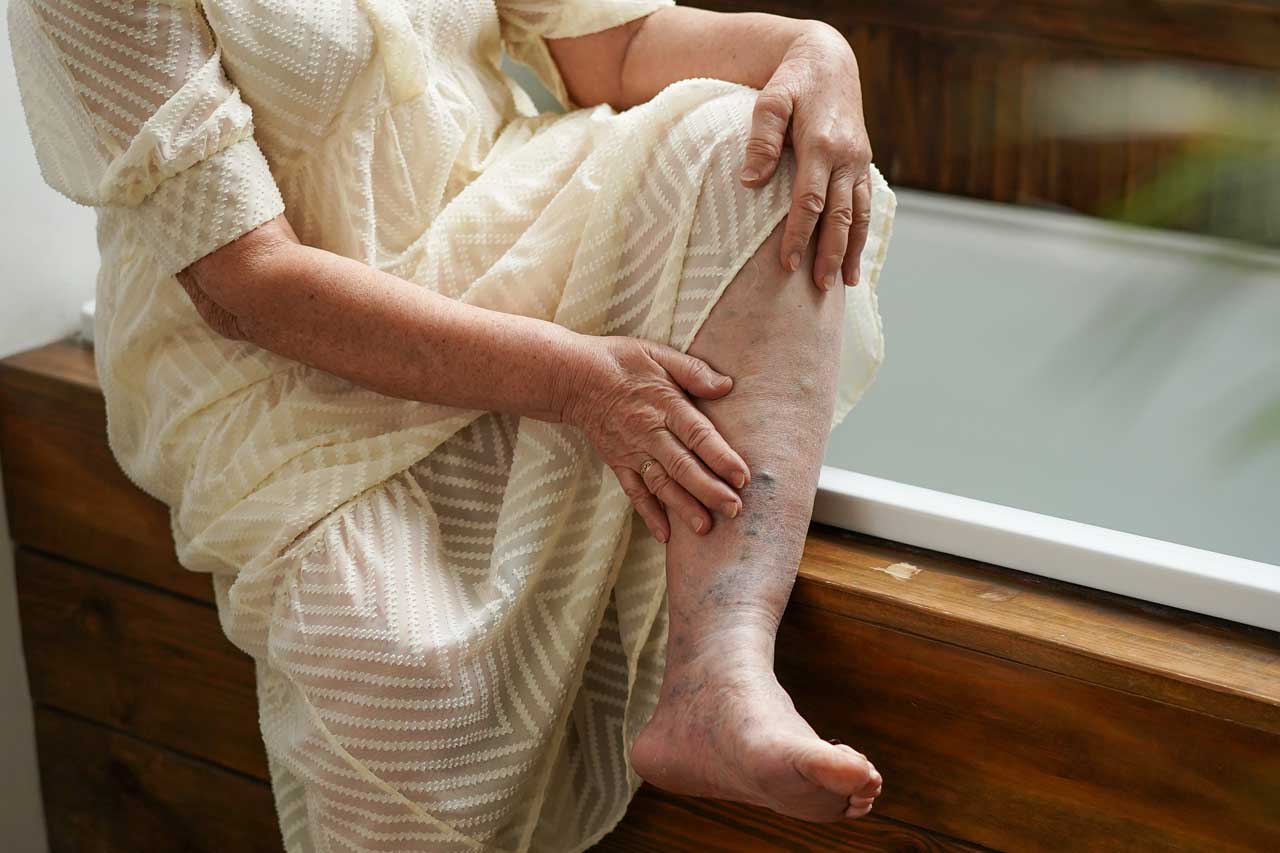Vascular Surgeon
Expert in the treatment of varicose veins
What is leg phlebitis? What can it be caused by? Is it dangerous?

What is phlebitis?
"Phlebitis" refers to inflammation of a vein.
Phlebitis" is actually the "thrombosis" of a vein, i.e. the presence of a clot (thrombus) in a vein. The presence of a clot in a vein causes inflammation, hence the term phlebitis.
To be more precise, we speak of thrombophlebitis.
What is paraphlebitis or deep phlebitis?
“Paraphlebitis” is "superficial phlebitis", i.e. thrombosis of a vein in the superficial network (in the subcutaneous tissue). Typically, this is the presence of a clot in a varicose vein. Thrombosis may involve not only the varicose branches beneath the skin, but also the saphenous veins into which these branches drain.
There is also deep phlebitis, which affects the deep veins, i.e. the veins located in the leg muscles. Involvement of the deep veins is more worrying, as thrombosis can spread to the thigh and beyond to the abdominal veins (iliac veins and vena cava).
What are the signs of phlebitis?
The two main signs are pain and swelling of the leg (edema).
The pain is most often at the back of the calf, more or less permanent and persistent, with discomfort when walking that can lead to limping. It can also affect the thigh.
The other important sign is edema, usually swelling of the ankle and calf, which is permanent but can vary in severity. Swelling can extend to the thigh when phlebitis affects veins in the thigh or abdomen.
These two signs are not necessarily present together, as pain and edema can exist in isolation.
Sometimes the pain and/or swelling may be minimal (or even absent) and not raise an alarm.
These forms of phlebitis, which may or may not be symptomatic, are extremely dangerous, as the diagnosis is not made at the outset, and will be revealed when a complication occurs.
How is phlebitis diagnosed?
The diagnosis of phlebitis is made on clinical examination, which reveals pain on palpation of the calf muscles, pain on flexion-extension of the ankle, warmth of the skin, edema of the leg, and sometimes painful, indurated redness of the skin in the case of superficial phlebitis.
There is also a biological test that can detect phlebitis through a simple blood test. This is the "D-dimer" test, performed by a simple blood test. If this biological test is negative (D-dimer levels are normal), it is almost certain that phlebitis is not present. On the other hand, an increase in D-dimer levels may be the result of other inflammatory phenomena. It is the clinical context that will guide the diagnosis when D-dimer levels are elevated.
Ultrasound-Duplex examination provides diagnostic certainty +++.
This essential diagnostic test will reveal the precise presence of the clot, its superficial or deep location and its extent across the limb.
This test should be performed at the slightest suspicion of phlebitis, in the presence of suggestive signs or elevated D-dimer levels.
What situations can lead to phlebitis?
First of all, any situation of prolonged immobility or limited mobility (bed rest or sitting position) is a risk factor for phlebitis. Indeed, immobility of the lower limbs prevents the calf muscle pump from draining blood from the legs, leading to blood stagnation in the venous network (see blog "How leg veins work"). This stagnation favors the formation of clots in the veins, leading to phlebitis.
One of the best-known situations is a long seated journey, particularly by air travel (see blog "Air travel and the risk to venous circulation").
Illness, trauma (especially if it requires a cast), loss of autonomy or surgery are also risk factors.
In the event of illness, trauma or surgery, not only may the patient be bedridden, but illness, trauma and surgery also lead to widespread inflammation in the body, increasing the risk of phlebitis.
There are sometimes disorders of the coagulation system that can lead to phlebitis. This is known as thrombophilia. Thrombophilia is detected by means of a number of highly specific biological tests, using a blood sample. Thrombophilia is generally detected after the onset or recurrence of phlebitis. Diagnosis of thrombophilia is useful, as it indicates the risk of new phlebitis in the person tested, enabling the occurrence of phlebitis to be anticipated in high-risk situations. Since thrombophilia is genetic in origin, it may be useful to screen for thrombophilia in the family of a positive person, again to prevent the onset of phlebitis in high-risk situations.
Other common risk factors are obesity, pregnancy and aging. These can be added to the risk factors listed above.
What are the possible complications of phlebitis?
There are two types of complications: acute and chronic.
Acute complications include phlebitis spreading from the calf to the thighs and beyond to the abdomen. This can lead to increased pain and/or swelling.
The most serious acute complication is pulmonary embolism: this occurs when part of the clot in the vein breaks away and migrates upwards towards the heart, then the vessels of the lungs, which the clot can block. This complication is potentially fatal, because if it is massive (large clot), it can lead to cardiorespiratory arrest.
The chronic complication is essentially represented by the so-called post-thrombotic syndrome. This is the consequence of severe destruction or damage to the veins, which can no longer effectively drain venous blood, leading to a chronic increase in venous pressure.
This can lead to permanent swelling (chronic edema) and then to skin lesions, with the skin becoming progressively pigmented, rigid, indurated and fragile. This is known as hypodermatitis, and is most often found above the ankle.
The presence of hypodermatitis raises fears of venous ulcers, which are very difficult to heal permanently.
How is phlebitis treated?
The mainstay of phlebitis treatment is anticoagulant therapy.
Anticoagulant treatment helps limit clot extension and/or recurrence. . It must be carried out as a matter of urgency, as soon as the diagnosis of phlebitis is established.
Usually started as a subcutaneous injection (heparin), this treatment is most often rapidly administered in tablet form, traditionally anti-vitamin K (known as AVK).
Over the last ten years or so, new oral anticoagulants have appeared on the market, with the major advantage of being much more stable than VKAs, with no need for regular blood tests.
An initial deep phlebitis will require anticoagulant treatment for at least three months. A recurrence or pulmonary embolism will require prolonged treatment.
In the case of superficial phlebitis, treatment with heparin injections lasting a few weeks is usually sufficient.
The other essential treatment for phlebitis is the use of compression bandages or stockings. Venous compression improves venous drainage and limits venous pressure, preventing clot extension or recurrence, and reducing swelling, inflammation and pain.
Finally, it is essential to restore the patient's ability to walk as quickly as possible, as soon as anticoagulant treatment has been started. Walking also promotes venous drainage, thanks to the calf muscles, reducing congestion and clot extension.
The idea that a patient suffering from phlebitis should remain in bed after receiving an anticoagulant +++ must be rejected.
In certain cases of phlebitis involving an obstacle in the veins of the pelvis (iliac veins), removal of the obstacle by dilatation inside the vein with a "stent" (a kind of spring) may be considered.
Studies show that in this situation, removing the obstacle prevents the onset of a post-thrombotic syndrome and radically changes patients' quality of life.
This is particularly true in young patients with phlebitis of the left lower limb.
How can phlebitis be prevented?
The simplest way to prevent phlebitis is to wear a compression stocking in a situation or in the presence of a risk factor (see above).
For example, if you're going on a long trip while seated, or if you're bedridden or disabled, or after surgery, we strongly recommend that you wear a stocking.
Walking is also recommended whenever possible in high-risk situations.
When there is a history of phlebitis, or in certain particularly high-risk situations, preventive anticoagulant treatment by injection of heparin will be carried out.
In summary
Phlebitis is often associated with pain and/or swelling of the leg, symptoms that should raise the alarm, especially in high-risk situations.
Diagnosis is straightforward, and must be carried out as a matter of urgency, as must treatment with anticoagulants once the diagnosis has been made, since phlebitis can lead to potentially serious, even fatal, complications. The patient must regain mobility as soon as anticoagulant treatment has been started.
Phlebitis is sometimes silent, which makes it formidable.
As such, it must be prevented in high-risk situations, especially if there is a favorable context.
In the vast majority of cases, treatment is simple and effective.




